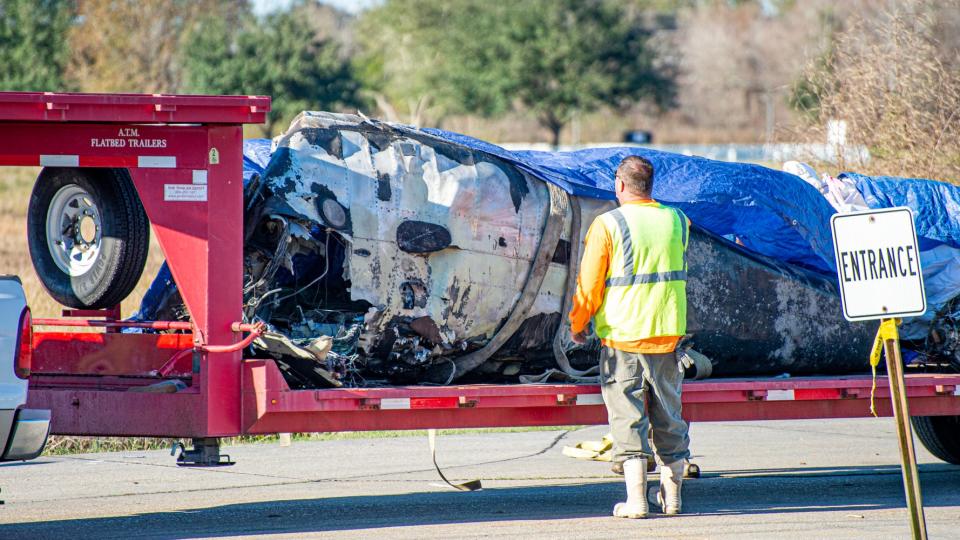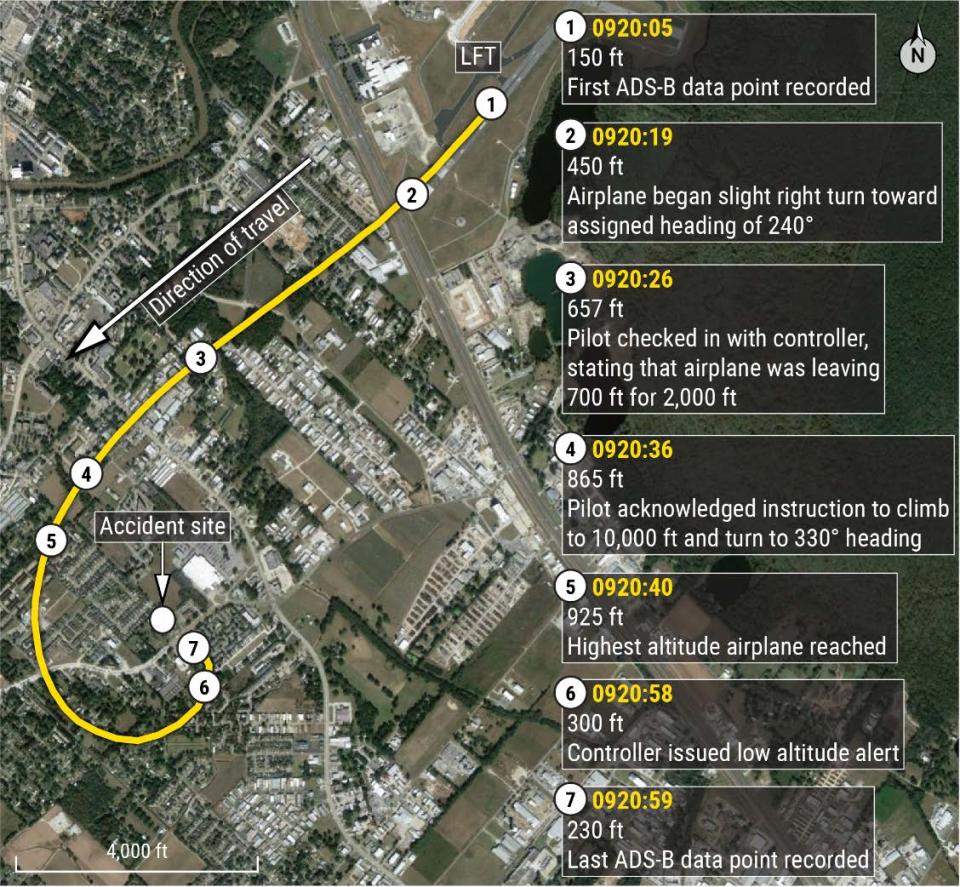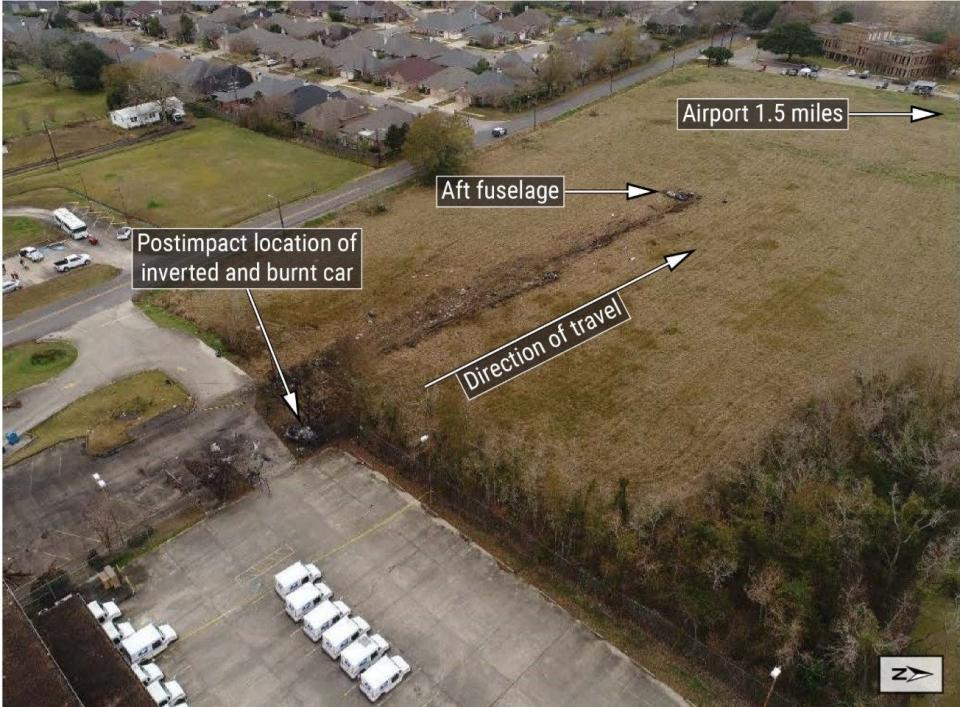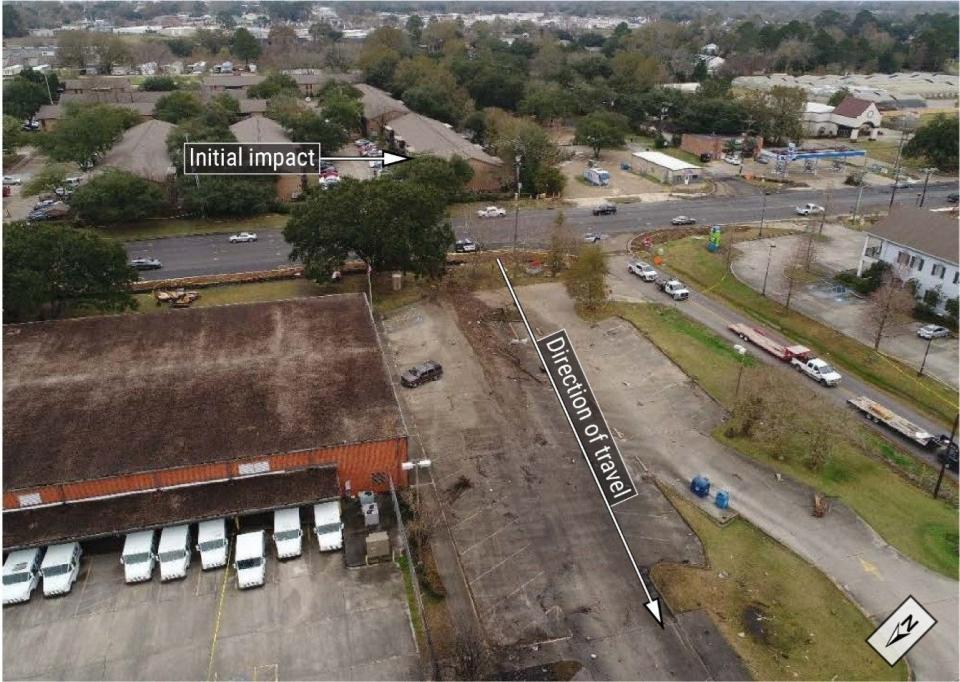Pilot's disorientation, weather led to Lafayette plane crash that killed five, NTSB says
An earlier version of this report misstated the owner of the crashed plane. We regret the error.
The pilot of a plane that crashed in Lafayette and killed five of the six people aboard in December 2019 became spatially disoriented and lost control of the plane, the National Transportation Safety Board concluded in its final report.
The small passenger plane was bound for Atlanta to watch the Louisiana State University football team play a semifinal game in the Peach Bowl when it crashed on Dec. 28, 2019, shortly after taking off from Lafayette Regional Airport.
The crash killed pilot Ian Biggs and passengers Carley McCord, Vaughn Crisp, Gretchen Vincent and Michael Walker Vincent. The sixth passenger, Stephen Wade Berzas, was treated for burns that covered 75% of his body.
A bystander, Danielle Britt, who was in the post office's parking lot, where the plane first made impact with the ground, also was injured and suffered burns to 30% of her body.
About the victims: A 15-year-old, a mother, a pilot, a 'great friend,'
“In summary, post accident examination of the airplane structures and systems revealed no anomalies that would have precluded normal operation," the NTSB wrote in its final report released Thursday.
"The weather conditions at the time of takeoff were conducive to the development of spatial disorientation. The lack of visual references and the airplane’s increasing pitch attitude likely caused the pilot to become spatially disoriented during the initial climb, as evidenced by the airplane’s continuing and tightening turn to the left away from the intended course.
"Thus, the pilot’s spatial disorientation led to his loss of control of the plane."

What did the NTSB's investigation find?
The Piper PA-31T, which was owned by an LLC run by Charles E. Vincent, was cleared by air traffic control to take off from LFT at 9:18 a.m.
Michael Walker Vincent, Charles Vincent's grandson, was a student pilot and was in the plane's right front seat. The 15-year-old was issued his student pilot certificate on Sept. 29, 2019.
Berzas, the crash's only survivor, and Crisp sat behind Biggs while McCord and Gretchen Vincent sat behind Michael Walker Vincent, Berzas told investigators.
Previous coverage: NTSB documents reveal more details into fatal Lafayette plane crash bound for Peach Bowl
When the plane took off, it started by following the flight path given by the air traffic controller. The plane reached its highest altitude at 925 feet at 9:20 a.m. and crashed seconds later. There was no mayday alert issued from the cockpit, the NTSB said.

Berzas later told the investigator the airplane ride felt as he had experienced it before. He said the airplane “pitched up like the pilot was trying to get above or over the clouds” and that a “harder than normal pitching movement" had occurred.
Michael Walker Vincent said they were going up. A few moments later, Vincent said "we are going down people," Berzas said.
The airplane did not have, nor was it required to have, a cockpit voice recorder or flight data recorder.
The plane struck trees and powerlines before striking the ground, traveled across a parking lot and struck a car, according to the report. The car rolled several times and came to rest upside down before bursting into flames.
The airplane shredded as it traveled through a field next to a U.S. Post Office. The right wing, outboard left wing, left and right engines, left and right elevator controls, rudder, instrument panel and forward cabin separated from the body of the plane, which was fragmented and exposed to heat and fire.
Because of the low visibility the day of the crash, which the NTSB said were "conducive to the development of spatial disorientation," and Berza's description of the pitch of the plane, the NTSB said Biggs likely experienced spatial disorientation.
It also said the airplane's continuing and tightening turn to the left away from the intended course also indicated Biggs had become spatially disoriented.

Spatial disorientation is defined by the Federal Aviation Administration as a “loss of proper bearings; state of mental confusion as to position, location or movement relative to the position of the earth.”
The FAA’s handbook for flying states that the vestibular sense, which is motion sensing by the inner ear, can and will confuse the pilot creating false sensations that lead the pilot to believe the attitude of the plane has changed, even though it hasn’t.
Because of that, a pilot “needs to believe what the flight instruments show” regardless of what their senses tell them.
Biggs, 51, had about 1,530 hours of flight experience, about 730 of those were in the plane that crashed, according to the NTSB.
The owner of the company that owned the plane told investigators Biggs was “proficient” in the airplane. The owner of the plane told investigators Biggs had “a lot of involvement” with the plane and “wanted to be the very best that he could be” at operating it.
Biggs had training in April 2019, but the instructor’s FAA-issued flight instructor certificate had expired in February 2019. The NTSB said Biggs may not have been aware of the instructor pilot’s expired license.
The NTSB said it could not tell from the pilot log book if Biggs met the regulatory requirements for instrument experience.
The NTSB did not find anomalies that would have prevented normal operation of both engines. Both had impact and fire damage after the crash. Weight and balance calculations showed that the airplane’s total weight and center of gravity were within limits.

Damage to the propellers was consistent with impact forces, according to the report. There also were no abnormal propeller sounds on recordings provided by neighbor houses after the crash.
More: Shreveport student receives first Northwestern State scholarship in Carley McCord's honor
Autopilot was not likely engaged during the flight, the NTSB found. It also found that an aerodynamic stall did not occur.
There was no recorded data to show the NTSB the attitude and heading information that would have been displayed to Biggs during the flight.
Britt; Berzas; relatives of Crisp, McCord and the Vincents; and some bystanders who witnessed the crash are seeking damages against the insurance companies, the plane's owners and pilot. They filed lawsuits in Lafayette's U.S. District Court in the Western District of Louisiana.
The full report can be read here:
Contact Ashley White at adwhite@theadvertiser.com or on Twitter @AshleyyDi.
This article originally appeared on Lafayette Daily Advertiser: Lafayette Plane crash: Pilot's disorientation led to crash NTSB said

